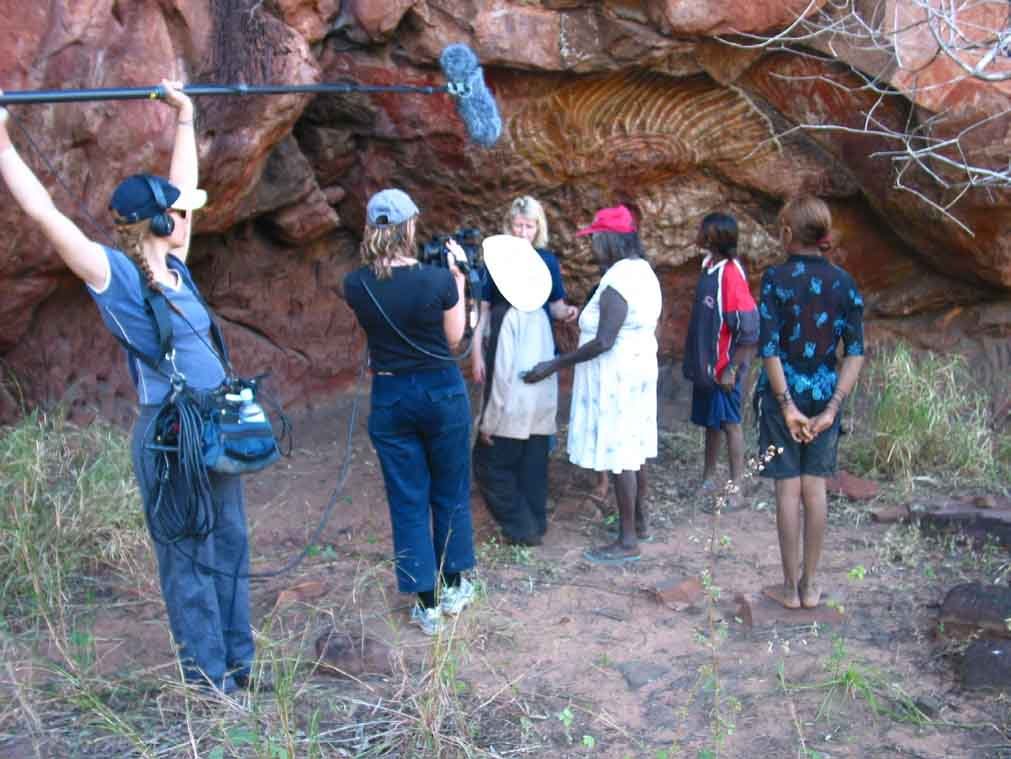Women's Business is an unique film which identifies how young Aboriginal (Wardaman) females were instructed into understanding and learning about their own development at puberty and just how this is linked to ancient cultural traditions involving their part in the link to Wardaman lands.
This film concentrates on an Aboriginal woman Lily Gin.gina. At the age of 74 she is the last senior female elder in her country with full traditional knowledge. She typifies a person who has moved from traditional Aboriginal life in her own country, to her involvement in the colonial pastoral occupation of it, (Willeroo, Delamere, Scott Creek and Innesvale Stations) then moving into town (Katherine) and finally returning to her homelands (Menngen Station as a Native Title Claim) where she can educate her granddaughters.
Queenie, Lily and Julie at Nimira Site.
Lily and Julie viewing the rock art.
The girls with the crew at the campsite.
Engraved Maralabena figure with initiation headress.
Rock painting of Yimidj brothers.
Engraved figure of pregnant Nimira.
Simone, Bill Harney's grandaughter.
Miriam, Valery and Megan.
The film crew. Sound recordist, Bella Kenworthy and Jo Parker cinephotographer, with Lily and grandchildren.
The film takes the viewer through some processes of understanding cultural knowledge and stages of girl's initiation.
Lily revisits clan country with her granddaughters to keep the spirits alive. They visit Maralabena and other totemic paintings at Bunnanggaiya mountain.
Lily and Julie take the children to see the rock paintings of the creation frog woman, Dungdung and the birthing process is explained. The story of the creation ancestors connects the girls to the spirituality of their country.
Reviewing her own past, Lily visits her old camp at Willeroo Station and talks about her first period when living on the pastoral station.
Knowledge of 'skin' names is an important part of understanding kinship relations with alliance of land and clan marriages.
Understanding the law is demonstrated through various paintings and engravings. Moon established laws and broke others. His power is transferred into a special red clay which the girls find out is used for 'love magic'.
The girls go out for a bush camp, collect ochre and paint up for the ceremonial dance.
The Mordu dances mark the final stage of initiation
The girls discuss their views of these traditions and bush education while painting.
Today the girls who have grown up in the township of Katherine have lost the knowledge of the ancestors traditions but Lily, the senior elder helps the girls to restore and understand these processes of initiation into womanhood. The film embraces the richness and depth of Wardaman women's culture connected with the rock art of Wardaman country. Lily's friendship with Julie Drew, an ethnographic archaeologist who previously recorded the Wardaman Dreaming stories demonstrates that all young Australians want to understand Aboriginal cultural ways.
Popular belief is that rock paintings and engravings are men's activities and relate to male ceremonial practices. Women also use these images for teaching young girls the women's law. In the past women's business was secret and never discussed in mixed company. Through the media of television and DVD film the Wardaman people find that they want to share their traditions.
As well as Lily and other senior women Bill Harney, the senior male elder and Chairman of the Council of Wardaman Elders gave his sanction to this project. A man can know about women's business but cannot be present at ceremonies he said. Bill Harney and Lily Gin.gina decided to ask Julie to return to Wardman Country and together they made this film over two years and then Julie took another year editing the film and preparing the DVD with education notes for teachers
The Wardaman Aboriginal Corporation was formed in 1996 and it owns the land of the Native Title Claim at Innesvale (Menngen) Station. There is also an office in Katherine which is run by the Wardaman. They have a library there and DVD player so that those from the community living in town can come and watch the DVD and other works carried out with Wardaman people.
Julie Drew completed a Master of Philosophy thesis at University of Sydney in 2001 after working with Wardaman people for four years. Her book is "Animal Connections in Rock Art, Landscape and Dreaming Tracks. An informed archaeology of the Wardaman People of Northern Territory." She also holds a BA (Honours in Archaeology) Degree, 1991 and wrote about "Depictions of Women and Gender Relations in Rock Art of Australia".








